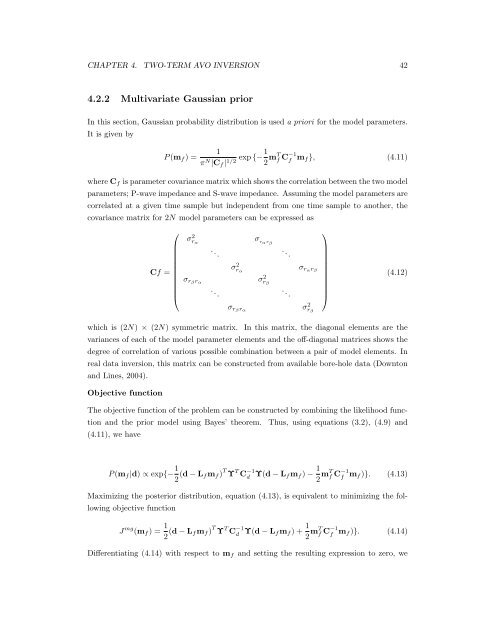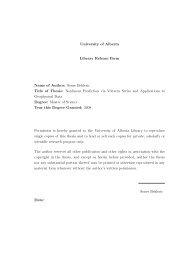Regularization of the AVO inverse problem by means of a ...
Regularization of the AVO inverse problem by means of a ...
Regularization of the AVO inverse problem by means of a ...
You also want an ePaper? Increase the reach of your titles
YUMPU automatically turns print PDFs into web optimized ePapers that Google loves.
CHAPTER 4. TWO-TERM <strong>AVO</strong> INVERSION 42<br />
4.2.2 Multivariate Gaussian prior<br />
In this section, Gaussian probability distribution is used a priori for <strong>the</strong> model parameters.<br />
It is given <strong>by</strong><br />
P (mf ) =<br />
1<br />
πN exp {−1<br />
|Cf | 1/2 2 mTf C −1<br />
f mf }, (4.11)<br />
where Cf is parameter covariance matrix which shows <strong>the</strong> correlation between <strong>the</strong> two model<br />
parameters; P-wave impedance and S-wave impedance. Assuming <strong>the</strong> model parameters are<br />
correlated at a given time sample but independent from one time sample to ano<strong>the</strong>r, <strong>the</strong><br />
covariance matrix for 2N model parameters can be expressed as<br />
⎛<br />
⎜<br />
Cf = ⎜<br />
⎝<br />
σ 2 rα<br />
σrβrα<br />
. ..<br />
. ..<br />
σ 2 rα<br />
σrβrα<br />
σ rαrβ<br />
σ 2 rβ<br />
. ..<br />
. ..<br />
σrαrβ<br />
σ 2 rβ<br />
⎞<br />
⎟<br />
⎠<br />
(4.12)<br />
which is (2N) × (2N) symmetric matrix. In this matrix, <strong>the</strong> diagonal elements are <strong>the</strong><br />
variances <strong>of</strong> each <strong>of</strong> <strong>the</strong> model parameter elements and <strong>the</strong> <strong>of</strong>f-diagonal matrices shows <strong>the</strong><br />
degree <strong>of</strong> correlation <strong>of</strong> various possible combination between a pair <strong>of</strong> model elements. In<br />
real data inversion, this matrix can be constructed from available bore-hole data (Downton<br />
and Lines, 2004).<br />
Objective function<br />
The objective function <strong>of</strong> <strong>the</strong> <strong>problem</strong> can be constructed <strong>by</strong> combining <strong>the</strong> likelihood func-<br />
tion and <strong>the</strong> prior model using Bayes’ <strong>the</strong>orem. Thus, using equations (3.2), (4.9) and<br />
(4.11), we have<br />
P (mf |d) ∝ exp{− 1<br />
2 (d − Lf mf ) T Υ T C −1<br />
d Υ(d − Lf mf ) − 1<br />
2 mT f C −1<br />
f mf )}. (4.13)<br />
Maximizing <strong>the</strong> posterior distribution, equation (4.13), is equivalent to minimizing <strong>the</strong> fol-<br />
lowing objective function<br />
J mg (mf ) = 1<br />
2 (d − Lf mf ) T Υ T C −1<br />
d Υ(d − Lf mf ) + 1<br />
2 mT f C −1<br />
f mf )}. (4.14)<br />
Differentiating (4.14) with respect to mf and setting <strong>the</strong> resulting expression to zero, we









